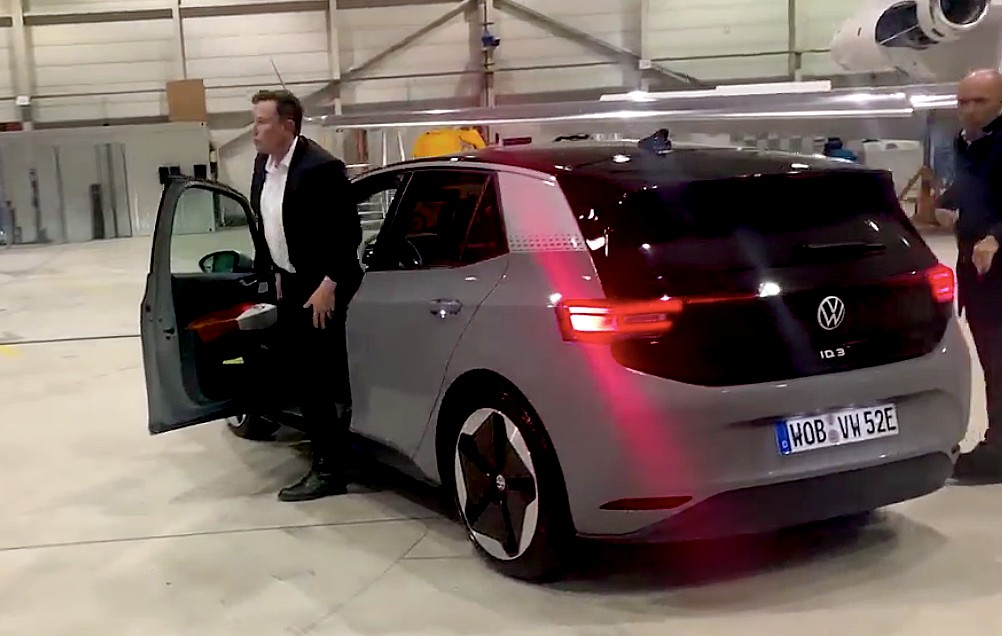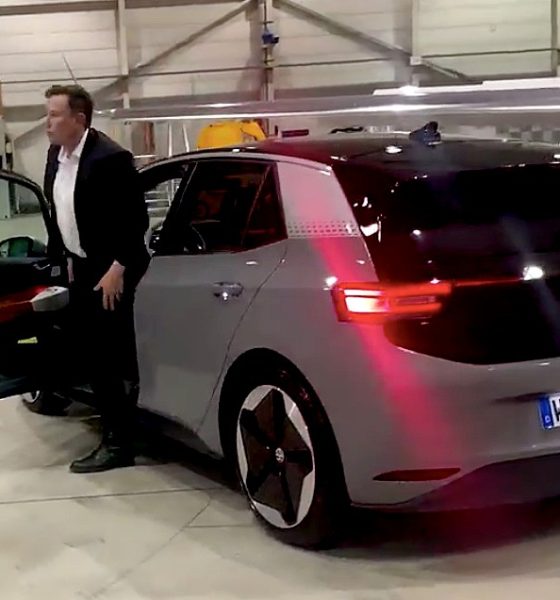

News
Volkswagen gets FUD over its “irritatingly energetic” EV strategy
Volkswagen is serious about its electric vehicle business. This is evident in the German automaker’s efforts to release its first mass-market electric car, the ID.3. The vehicle has received its own fair share of acclaim and criticism since its release, but as Volkswagen continues its EV push with the ID.4 crossover, it appears that the veteran automaker is now dealing with something that Tesla has been battling: anti-electric car FUD.
In a recent article on Cicero Magazine, author Nils Heisterhagen sharply criticized Volkswagen for its “irritatingly energetic” focus on electric vehicles. The author questioned the veteran automaker’s dedication to battery-only vehicles, stating that alternative fuels are a better option, since most cars will have a combustion engine in the future anyway. “Shouldn’t we focus on synthetic fuels when most cars will have combustion engines in the foreseeable future?” the EV critic noted.
The author also criticized Volkswagen for pushing electric cars so much when the development of charging infrastructure for EVs will be extremely expensive. Heisterhagen cited a study from the Handelsblatt Research Institute claiming that 1,000,000 electric cars would require the support of 100,000 charging stations. Considering these challenges, the author argued that it would have been more practical if Volkswagen had focused on alternative fuels like hydrogen instead.
“Building the charging infrastructure is extremely expensive. For Germany alone, we are talking about multi-billion investments by 2030 – and that in addition to the existing filling station infrastructure. So why not use the existing filling station infrastructure – for hydrogen and e-fuels?” Heisterhagen wrote, lamenting the automaker’s resistance to hydrogen and other alternative fuels.
Electric mobility expert Auke Hoekstra has responded to Heisterhagen’s points, defending Volkswagen and setting the record straight about why all-electric vehicles will likely be the reason why the veteran German automaker will thrive in the EV age. According to Hoekstra, the author’s points don’t hold any water since synthetic fuels require a lot of energy and are thus extremely expensive. This is the same for e-fuels and hydrogen.
This is extremely ironic considering that the author was criticizing EVs over the cost of their charging infrastructure. Hoekstra noted that if one were to run the numbers, the massive costs associated with the rollout of an EV charging infrastructure would likely be “pocket change” compared to the costs of developing and transitioning into alternative fuels. With this in mind, the electric mobility expert argued that the aggressive EV push from Volkswagen is a step in the right direction after all.
“I must say that the “irritatingly energetic” (the writer’s words) of the electric drivetrain by Volkswagen is the only reason still see a future for the German car industry,” Hoekstra wrote.
Volkswagen’s EV push has earned the respect of electric car leaders like Tesla CEO Elon Musk, who previously stated that the automaker, under the guiding hand of Herbert Diess, is “doing more than any big carmaker to go electric.” Musk has shown his support for Volkswagen’s electric car efforts, even test-driving the ID.3 with Diess during his recent visit to Germany. A video taken during the test drive showed that the Tesla CEO and the VW executive were on friendly terms, with Musk even joking “What’s the worst that could happen?” while flooring the ID.3.

News
Elon Musk’s Grokipedia surges to 5.6M articles, almost 79% of English Wikipedia
The explosive growth marks a major milestone for the AI-powered online encyclopedia, which was launched by Elon Musk’s xAI just months ago.

Elon Musk’s Grokipedia has grown to an impressive 5,615,201 articles as of today, closing in on 79% of the English Wikipedia’s current total of 7,119,376 articles.
The explosive growth marks a major milestone for the AI-powered online encyclopedia, which was launched by Elon Musk’s xAI just months ago. Needless to say, it would only be a matter of time before Grokipedia exceeds English Wikipedia in sheer volume.
Grokipedia’s rapid growth
xAI’s vision for Grokipedia emphasizes neutrality, while Grok’s reasoning capabilities allow for fast drafting and fact-checking. When Elon Musk announced the initiative in late September 2025, he noted that Grokipedia would be an improvement to Wikipedia because it would be designed to avoid bias.
At the time, Musk noted that Grokipedia “is a necessary step towards the xAI goal of understanding the Universe.”
Grokipedia was launched in late October, and while xAI was careful to list it only as Version 0.1 at the time, the online encyclopedia immediately earned praise. Wikipedia co-founder Larry Sanger highlighted the project’s innovative approach, noting how it leverages AI to fill knowledge gaps and enable rapid updates. Netizens also observed how Grokipedia tends to present articles in a more objective manner compared to Wikipedia, which is edited by humans.
Elon Musk’s ambitious plans
With 5,615,201 total articles, Grokipedia has now grown to almost 79% of English Wikipedia’s article base. This is incredibly quick, though Grokipedia remains text-only for now. xAI, for its part, has now updated the online encyclopedia’s iteration to v0.2.
Elon Musk has shared bold ideas for Grokipedia, including sending a record of the entire knowledge base to space as part of xAI’s mission to preserve and expand human understanding. At some point, Musk stated that Grokipedia will be renamed to Encyclopedia Galactica, and it will be sent to the cosmos.
“When Grokipedia is good enough (long way to go), we will change the name to Encyclopedia Galactica. It will be an open source distillation of all knowledge, including audio, images and video. Join xAI to help build the sci-fi version of the Library of Alexandria!” Musk wrote, adding in a later post that “Copies will be etched in stone and sent to the Moon, Mars and beyond. This time, it will not be lost.”
News
Tesla Model 3 becomes Netherlands’ best-selling used EV in 2025
More than one in ten second-hand electric cars sold in the country last year was a Tesla Model 3.

The Tesla Model 3 became the most popular used electric car in the Netherlands in 2025, cementing its dominance well beyond the country’s new-car market.
After years at the top of Dutch EV sales charts, the Model 3 now leads the country’s second-hand EV market by a wide margin, as record used-car purchases pushed electric vehicles further into the mainstream.
Model 3 takes a commanding lead
The Netherlands recorded more than 2.1 million used car sales last year, the highest level on record. Of those, roughly 4.8%, or about 102,000 vehicles, were electric. Within that growing segment, the Tesla Model 3 stood far ahead of its competitors.
In 2025 alone, 11,338 used Model 3s changed hands, giving the car an 11.1% share of the country’s entire used EV market. That means more than one in ten second-hand electric cars sold in the country last year was a Tesla Model 3, Auto Week Netherlands reported. The scale of its lead is striking: the gap between the Model 3 and the second-place finisher, the Volkswagen ID3, is more than 6,700 vehicles.
Rivals trail as residual values shape rankings
The Volkswagen ID.3 ranked a distant second, with 4,595 used units sold and a 4.5% market share. Close behind was the Audi e-tron, which placed third with 4,236 registrations. As noted by Auto Week Netherlands, relatively low residual values likely boosted the e-tron’s appeal in the used market, despite its higher original price.
Other strong performers included the Kia Niro, the Tesla Model Y, and the Hyundai Kona, highlighting continued demand for compact and midsize electric vehicles with proven range and reliability. No other model, however, came close to matching the Model 3’s scale or market presence.
News
Tesla Model Y Standard Long Range RWD launches in Europe
The update was announced by Tesla Europe & Middle East in a post on its official social media account on X.

Tesla has expanded the Model Y lineup in Europe with the introduction of the Standard Long Range RWD variant, which offers an impressive 657 km of WLTP range.
The update was announced by Tesla Europe & Middle East in a post on its official social media account on X.
Model Y Standard Long Range RWD Details
Tesla Europe & Middle East highlighted some of the Model Y Standard Long Range RWD’s most notable specs, from its 657 km of WLTP range to its 2,118 liters of cargo volume. More importantly, Tesla also noted that the newly released variant only consumes 12.7 kWh per 100 km, making it the most efficient Model Y to date.
The Model Y Standard provides a lower entry point for consumers who wish to enter the Tesla ecosystem at the lowest possible price. While the Model 3 Standard is still more affordable, some consumers might prefer the Model Y Standard due to its larger size and crossover form factor. The fact that the Model Y Standard is equipped with Tesla’s AI4 computer also makes it ready for FSD’s eventual rollout to the region.
Top Gear’s Model Y Standard review
Top Gear‘s recent review of the Tesla Model Y Standard highlighted some of the vehicle’s most notable features, such as its impressive real-world range, stellar infotainment system, and spacious interior. As per the publication, the Model Y Standard still retains a lot of what makes Tesla’s vehicles well-rounded, even if it’s been equipped with a simplified interior.
Top Gear compared the Model Y Standard to its rivals in the same segment. “The introduction of the Standard trim brings the Model Y in line with the entry price of most of its closest competition. In fact, it’s actually cheaper than a Peugeot e-3008 and costs £5k less than an entry-level Audi Q4 e-tron. It also makes the Ford Mustang Mach-E look a little short with its higher entry price and worse range,” the publication wrote.








